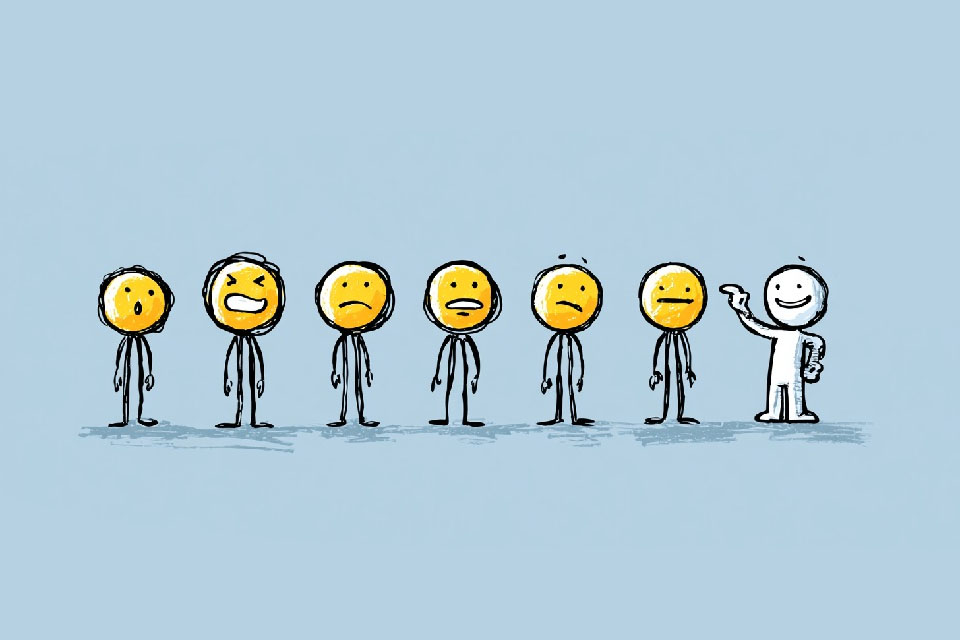Self-efficacy and collective efficacy in the team
Ready for an exciting comparison? It is not only in today’s working world that self-efficacy and collective efficacy are decisive for the success of teams. But how do these two power players fare in different working environments such as the classic office and the highly topical discussion area of home office? We get to the bottom of the question and shed light on the differences between the spatial working environment and the “I can do it” attitude as well as the “together we rock it” feeling.
Self-efficacy expectation – The power of persuasion
The foundations of self-efficacy have already been developed and studied in Bandura’s (1992, 1997, 2001) social cognitive theory. Bandura postulates that self-efficacy can be divided into competence and consequence expectations. Schwarzer et al. (2002) developed Bandura’s theory on self-efficacy expectancy further and emphasised that generalised self-efficacy expectancy is a stable personality dimension. It correlates positively with
- self-esteem,
- optimism and
- internal control and
- achievement motivation,
while it is negatively correlated with
- anxiousness,
- neuroticism and
- depressiveness.
Self-efficacy expectancy is an important resource of psychological capital (HERO resources: Hope, Efficacy, Resilience, Optimisms) and influences employee engagement and productivity. Examining the different cognitions is challenging, but they can be arranged hierarchically. A competence expectancy must be present for a consequence expectancy to arise, and a low consequence expectancy does not preclude a high competence expectancy (Schwarzer, 2004, p. 182). These findings are of fundamental importance, especially with regard to the commitment and productivity of employees in the work context (Luthans et al., 2004, p. 47).
Collective efficacy – The whole in a team format
When there is a shared belief in a team’s existing abilities to overcome and overcome difficult tasks, crises and obstacles together, this is called collective efficacy belief. Employees have great confidence in the company’s performance when the collective efficacy belief is high. Under challenging conditions, this collective efficacy is conducive to the individual empowerment of employees, their collective self-confidence and their performance. It can be strengthened through positive experiences, role models and trying out different methods (Bandura, 1998; Sutcliffe & Vogus 2003; Bruch & Vogel 2009).
Studies have shown that positively influencing leaders – also called “energising” (PONS Editorial, n.d.) – have a significantly positive effect on the performance, well-being, satisfaction, commitment and family life of individual employees. They strengthen organisational performance and the willingness to learn, innovate and work as a team (Cameron & McNaughtan, 2014). When supervisors express more positive emotions, they generate the same emotions in their employees. A trickle-down effect, a contagion process, is set in motion (Bono & Illies, 2006).
Cameron and McNaughtan thus postulate that leaders can influence performance, for example, through positive behaviour. But where is the starting point? How do leaders know that they should serve certain needs, values, motivators differently? The team climate inventory measures, among other things, participative safety and thus offers initial clues for leaders.
Organisational self-efficacy is a form of collective efficacy. The ever-increasing decentralisation, differentiation and specialisation of various activities increases the coordination effort in organisations and in the economy. A high level of collective self-efficacy can make it easier to cope with these challenges – even if the individual activities cannot be controlled centrally. The theory of collective self-efficacy is based on studies and theories of organisational learning (Senge, 1990) and theories of knowledge management (Probst et al., 1997). According to Bandura, it is a shared belief that the individual contributions and abilities of employees as a team lead to goal achievement. This belief is influenced team effectiveness, team performance, problem-solving ability, transformational leadership, job satisfaction and commitment (Bandura, 1997, p. 477).
Objective performance appraisal – where is such a thing?
That’s right – nowhere. Work performance cannot be presented objectively and comprehensively because it is human nature to have subjective perceptions. For simple things this works, but in complex environments and demanding knowledge work it quickly becomes complicated.
The core element of any organisation is its people. Without them, no products can be produced and no services can be provided. Organisations are therefore dependent on the performance of their employees in order to establish and maintain themselves in a competitive market in the long term (Sonnentag & Frese, 2003, pp. 453-491).
Performance is not objective – on the contrary. It is assessed very differently from one individual to another and perceived subjectively. The mere fact that performance is defined by people does not make it objective.
If we look at work performance from the perspective of personnel psychology, performance cannot be conceptualised only from the results of action, as the business perspective suggests. In many cases, especially in the course of the New Work movement, it is spoken of a contribution to the achievement of the organisation’s goals instead of individual performance (Marx, 2022, pp. 6-13; Contribution instead of Performance, 2022, pp. 52-55).
It is of fundamental importance that all employees pursue a common overarching corporate goal. The individual employees make their individual contribution in their teams and departments in order to be able to act successfully together with the other departments. For this reason, performance appraisals cannot be interpreted meaningfully only in relation to an individual person, but should also take into account other variables such as spatial factors, team structure and teamwork. But this assessment would turn out to be so complex that it can hardly be mapped in its entirety (New Narratives, 2022, pp. 6-13; 52-55).
Fascinating findings: Self-efficacy and collective efficacy in the home office and office in comparison
In our research, we took a close look at the question of whether subjective self-efficacy has a different impact on work performance in the home office than in the office. Using sbc and SOPTIM as case studies, we hypothesised and explored guiding questions to shed light on the issue. The results are extremely exciting: it turned out that subjective self-efficacy expectations and collective efficacy do indeed differ between home office and office. But that’s not all: work performance itself also varies between the two work environments.
The analysis of all guiding questions and the answers to the hypotheses lead to the conclusion that in the organisational contexts SOPTIM and sbc there is a correlation between self-efficacy expectation and work performance in the home office. Interestingly, self-efficacy expectancy even has a greater significance in the home office than in the office. Both individual self-efficacy expectation and collective efficacy have a significant influence on work performance, but not equally in all teams. Especially in teams with a high proportion of telework, these findings are highly relevant.
Each team member has an individual and subjective perception of their self-efficacy and the processes in each team are diverse. These findings are particularly interesting for managers who want to use positive psychology approaches to achieve higher work performance among their team members. Through verbal influences and vicarious experiences, it is possible to influence self-efficacy expectations, in addition to the individual’s perception of their own physiological and emotional states as well as their own experiences (Bandura, 1997, pp. 79-82; Luthans et al., 2004, p. 47).
Short and sweet
Let’s take another look at the classic office and the hip home office. What do they offer and what do self-efficacy, collective efficacy and work performance have to do with it?
Well, self-efficacy expectation plays a big role here. This is the conviction of being able to overcome a challenge. And it turns out that this is even more important in the home office than in the office. Because when you work at home, intrinsic motivation plays a much more important role than in the office. Without being able to say to oneself: “I can do this”, high performance is rather unlikely. But the verbalised external perception can make a big contribution. Also crucial is the shared feeling that together the team can make a difference, overcome obstacles and solve difficulties. This is called collective efficacy. When the team believes that they can overcome obstacles together, work performance increases. The same is true at the individual level. This is exactly the point where you can influence from the outside.
So there are differences between home office and office, but ultimately it comes down to how we believe in ourselves and the team. But that is exactly what can be developed in a targeted way with the right approaches.
Notes:
This article is a joint work by Sarah Jauer and Sascha Ruelicke. How managers can actively participate in the development of self-efficacy expectations and collective efficacy will be discussed in more detail in another article soon.
Would you like to share your experience with Sascha Rülicke? Then get in touch with him on LinkedIn. You will also find Sarah Jauer on LinkedIn.
- Bandura, A. (1982). Self-Efficacy mechanism in human agency. American Psychologist, 37, 122-147.
- Bandura, A. (1997) Self-Efficacy: The Exercise of Control. New York: W.H. Freeman and Company.
- Bandura, A. (1998). Personal and collective efficacy in human adaptation and change. In J. G. Adair, D. Bélanger, & K. L. Dion (Hrsg.), Advances in psychological science, Vol. 1. Social, personal, and cultural aspects, S. 51-71. Psychology Press/Erlbaum (UK) Taylor & Francis.
- Bandura, A. (2001). Social cognitive theory: An Agentic perspective. Annual Review of Psychology, 52, 1-26
- Bono, J. E. & Ilies, R. (2006). Charisma, Positive Emotions and Mood ContagionThe Leadership Quarterly, 17, 317-334, https://www.sciencedirect.com/science/article/abs/pii/S104898430600035X
- Brodbeck, F.C., & Maier, G.W. (2001). Das Teamklima-Inventar (TKI) für Innovationen in Gruppen: Psychometrische Überprüfung an einer deutschen Stichprobe. Zeitschrift für Arbeits- und Organisationspsychologie, 45, 2, S. 59-73.
- Bruch, H. & Vogel, B. (2009). Organisationale Energie. Wiesbaden: Gabler.
- Cameron, K. & McNaughtan, J. (2014). Positive organizational change. The Journal of Applied Behavioral Science, 50(4), 445–462.
- Creusen, U. & Eschemann, T. J. (2010). Positive Leadership. Psychologie erfolgreicher Führung.
- Luthans, F., Luthans, K. W. & Luthans, B. C. (2004). Positive psychological capital: Beyond human and social capital. Management Department Faculty Publications. 145.
- Marx, E. (2022). Leistung ist das, was wir dazu machen. In NN Publishing GmbH (Hrsg.), Neue Narrative, #15, 6-13. Berlin: Neue Narrative. Beitrag statt Leistung, 2022, S. 52-55).
- Porst, R. (2008), Fragebogen. Ein Arbeitsbuch, Wiesbaden.
- Schwarzer, R. (2014). Self-Efficacy. Thought Control of Action.
- Schwarzer, R., Jerusalem, M. & Weber, H. (2002). Gesundheitspsychologie von A bis Z. Göttingen: Hogrefe Verlag Für Psychologie.
- Spektrum. Lexikon der Psychologie. (n. d.). Selbstwirksamkeitserwartung.
- Senge, P. (1990). The Fifth Discipline: The Art and Practice of the Learning Organization. New York: Doubleday/Currency.
- Sonnentag, S. & Frese, M. (2013). Stress in organizations. In Weiner, I. B., Borman, W. C. Ilgen, D. R. & Klimoski, R. J. (Hrsg.). Handbook of psychology. Band 12: Industrial and Organizational Psychology. 2003, 453-491.
- Sutcliffe, K. & Vogus, T. (2003). Organizing for resilience. In K. Cameron, J. Dutton & R. Quinn (Hrsg.), Positive Organizational Scholarship: Foundations of a New Discipline, 94-110.
If you like the post or want to discuss it, feel free to share it with your network.
Sascha Ruelicke has published three more articles in the t2informatik Blog:

Sascha Rülicke
Sascha Ruelicke is Managing Director of sbc soptim business consult GmbH. Before joining sbc as a consultant in 2009, where he dealt with topics such as work and process design, innovation, innovation climate, project management and team and organisational development, he worked for almost seven years as a research assistant at the A.U.G.E. Institute of the Niederrhein University of Applied Sciences in applied research. In various research projects there, he got to know team and organisational development in small and medium-sized enterprises.

Sarah Jauer
Sarah Jauer is a business psychologist and consultant specialising in occupational and health psychology. She joined sbc in mid-2022 as a consultant and trainer of soft skill topics such as stress management, self-management & communication. Previously, she supported companies in optimising processes and overcoming challenges. Together with clients, she develops effective strategies for coping with stress in the work environment and supports their implementation.


